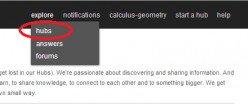Hierarchy Problem with New Breadcrumb Structure
I think it's great that HubPages is shifting more focus to authors, which should help keeping readers engaged.
While I do like the changes that HP made with the breadcrumbs, I discovered two problems with the new method.
The old method included a full breadcrumb navigation to Main Topic and Subtopic. The new method only provides a link to the Main Topic, which does not always properly represent the topic at all.
For example, I have a hub about Personal Development. But that is a subtopic under "Health → Quality of Life and Wellness → Personal Development"
The new breadcrumb only shows "Glenn Stok → Heath" and if someone clicks on "Health" it displays all my Health Hubs, which is not what the reader would be interested in if they were looking for other Personal Development articles.
I don't think Personal Development belongs under Health, and I can't find another existing Main Topic that works for this.
I realize the entire hierarchy of the breadcrumbs is very complex and therefore I don't know what the solution would be. I also realize that the "Show" Options in the profile only use the Main Topics, which is why it had to be programmed this way. I understand that.
So as a solution, I would like to recommend considering reworking the structure to move misplaced lower-end subtopics to a main topic level.
I realize HP programmers have a lot to do as it is. And they are indeed doing a great job. But as a systems programmer I tend to think of these things. Hope my thoughts are helpful.
The second problem is not really with the new method, but the lack of it. All the hubs that are Editor's Choice still have the old breadcrumb links that do not favor the author of the hub. 'Shifting more focus to authors' was indicated in the HP blog and HP's email as one of the reasons for making this change.Thanks for the input Glenn.
I'm following up with our engineering team and will let you know what I can find.Hi Glenn - We are sure glad to have you on the site. You bring to the table many talents to help us and the site. Thank you.
brakel2 - We're all in this together, trying to help one another. Thanks, Audrey, for your kind words.
Glenn.
I forwarded your suggestions and thoughts to our engineering team.
Currently we don't have plans to move more topics to the top level.
Thank again your for your input.
Glenn, Thanks for the thoughtful questions. I think some might find the history of topic pages and how they relate to breadcrumbs interesting.
For many years, it has been an SEO best practice to create an "Information Hierarchy" that grouped content together by topic. The first site I built like this was about nine years ago. The idea was pretty simple. Create a set of topic pages that targeted head keywords and link out to pages (articles) that targeted the tail. So, in practice I'd make a page about Apples (head page) and then link to pages about red apples, golden delicious etc. The search engines would tend to rank the tail pages higher when they were organized like this and if the topic page was great, occasionally a topic page would rank for a term that enjoyed a lot of traffic (apples). SEOs also thought that this was a good way to distribute internal pagerank by using breadcrumbs to link back to the topic pages from the articles. This was believed to then reflow the PR back through the site and give each page some love:)
We have done a number of tests on topic pages over the years. A few months ago we did some like this http://hubpages.com/topics/pets-and-ani … eping/4439 with more content.
In practice, the search engines want to send people to pages that are really good and try to avoid sending users to other search like results. On HubPages, the Hubs are where the meat is, so it makes sense that search engines rank the Hubs much better.
Topic pages are still a good way to organize content for parts of a search engine algorithms, but I contend they do little for passing substantial amounts of PR to Hubs unless they have some other characteristics.
I think the most important thing we can do is to make sure the navigation is intuitive to readers. I hope we are on the right track. Over time, we will be able to see if the clicks on breadcrumbs have changed.
The first question about the full topic path vs just the high level - The vast majority of people have a few hubs in each topic, so if we were to categorize at a low level, the filtered views would be pretty thin. However, there are ways to improve the display that we are considering so readers can get a view of what Hubs an author has on a topic. There are also some technical things about the implementation that could be different, although we want to be careful about how we do it. We have been reducing the number of pages in Google's index, so we want to avoid flooding it with thousands of pages. We can tell that Google can crawl the breadcrumbs, but we haven't set it up to allow each author topic page to be indexed (This is debatable on how we implemented it, so we may make some tweaks in the future).
Breadcrumbs on Subdomains vs EC. So, one of the things we are looking at is how to distinguish subdomain hubs from EC and to make sure that the navigation works for readers. EC Hubs are on the hubpages.com domain and the breadcrumbs link to hubpages.com topic pages for similar reasons as subdomain breadcrumbs now link to the author's site.
I really appreciate the feedback. I'll think more about what you have written. I'm looking for ways to improve the organization, strengthen subdomains and EC, and perhaps most importantly, improve the reader experience.Paul,
I thank you for taking the time to explain this in depth. You have brought up some interesting thoughts. I agree with the SEO consideration of using the breadcrumbs. I understand it well, as I had coded breadcrumbs on my business site too (you can check that out if you wish).
You are absolutely right that if hubs were categorized at a low level, the filtered views would be thin. And I would never suggest doing that for that very reason. I think you misunderstood me. I was suggesting adjusting only the low level topics that are misplaced, such as the example I gave in my first post... Why is the "Personal Development" topic under the Health topic?
Most topics are organized just fine. But I think the few low level that are under the wrong top level will not help search engines properly rank those particular subjects, as you were explaining.
This is even more apparent now after reading your SEO explanation. It makes me wonder now if that might be one of the reasons why some Hubbers who write really well are having Google treat their hubs as if poor quality -- simply because they are miscategorized.
Taking that into consideration, it may get even worse now for the few hubs that are miscategorized, since the top level is the only one used in the breadcrumbs now, and it has nothing to do with the subject of the particular hub. Most are okay, as i said. But I'm just talking about the few that are wrong.
It's hard for me to be more specific without giving you an exact example. If you want, I can email you a link to one of my hubs that shows what I'm talking about, if I didn't make myself clear.
Now, as for Breadcrumbs on Subdomains vs EC, I understand why the breadcrumbs for EC hubs link to HubPages' topic pages. I know it's because EC hubs are under hubpages.com rather than our subdomain. But that is taking away the advantage that was mentioned in your blog about the breadcrumbs... That HP is shifting more focus to authors.
I'm not arguing with you on that one, as I don't see a solution either. I'm just mentioning it since it's a deterrent from staying opted in with Editor's Choice. As I'm sure you know, more than 1/3rd of my hubs are EC and I'm hanging in there for now to give Google time to react to see if it helps. But staying opted in causes the breadcrumbs to be confusing now -- to readers and to search engines, since they work in different ways for EC hubs and subdomain hubs.
Thanks again, Paul, for your time -- and for the hard work everyone at HP is doing in the ongoing struggle to find solutions that lead to success for everyone. You know I do appreciate it.If the test on the Topic pages is the indication of the future of the site, I see some real problems: eleven duplicated internal links, a link to an external site that takes viewers away from HP, a nav bar moved down the page – below the fold – which is an inconsistent user experience, no SEO to rank the page for 'bees and beekeeping' (which is why it doesn't rank on search for the keyword phrase) and glaring grammatical errors. Further, the page now pushes all of the other Hubs down below the fold.
The page above the fold is poorly designed: there are no images, the font is inconsistent (links have a larger font than text) and the width of the text lines is much too long for readability online.
How is a user supposed to "distinguish subdomain Hubs from EC" by way of the navigation? As it is now, I can't even get to the Topic pages without logging off and entering the site from the homepage.
Is it your intention to feature all of the EC Hubs at the top of the Topic pages where you have inserted the eleven duplicate links in the example? If so, why do you think Google will like the content of those EC Hubs any better just because they have an extra, priority link from the Topic pages (Topic pages which now, because of the new navigation, have lost most of their PageRank)?
What was presented to the community as some kind of award for Hubs, which may or may not have had good traffic from Google prior their EC designation and the change in their URLs, is now presented to us as an effort to "distinguish subdomain Hubs from EC." In fact, it appears that you trying to build a website within a website. Can't be done. Either put all of the ECs on a separate website or put them on a separate subdomain. Confusion does not "improve the reader experience."As it is now, I can't even get to the Topic pages without logging off and entering the site from the homepage.
There's no need to log off. When you're logged in, go to the top navigation bar, hover over "explore" and then click "hubs" from the drop down menu. That takes you to the topic pages.
Thank you! I was so used to using the nav bars I forgot all about that.
Related Discussions
- 30
How to Get More Traffic to Your Pages and All of HubPages
by Chuck Bluestein 10 years ago
Now, not before, when you place a link, you have a choice to click rel=nofollow so that search engines ignore it. So in future hubs that you write or if you want to go back and edit, do not check this box for links to your own hubs. Also do not do this for links where you want to help the site. But...
- 52
Breadcrumb change announced on blog
by Writer Fox 10 years ago
There has been a major change on the HP platform that was not announced to the writing community.Go to one of your Hubs and look at the top where the breadcrumb navigation is. It now reads: your subdomain > main Topic category only (I presume that this is not the case for...
- 31
Does it take a while to see traffic to your sites?
by jfay2011 12 years ago
I am starting to learn how to social bookmark. I've been doing it on twitter, facebook, igoogle, digg, delicious, diigo, my blogs, pingomatic and a few other places. I have only been doing it on some of these sites for the last four or five days. It probably takes a while to see...
- 50
Why is HP Adding unrelated links to category pages?
by Elisabeth Sowerbutts 12 years ago
Hi I noticed recently that when hubs are listed in the Google search results the 2nd link doesn't got to the hub but to the category page - for example: You can see the tumblr page has the normal double link to the page ranked - but the hubpage doesn't the 2nd link is to...
- 29
Huge Amount of Quick Vital Questions
by KnowledgeAnywhere 13 years ago
I have been on hubpages for two months. I have read multiple articles on SEO and backlinking. Ninety percent of my hubs do not have backlinking. But I choose for a while to say no backlinking. It was "different" I thought and "original". ...
- 93
Still trying to determine if Hub Pages is worthwhile or not!!
by johnfl 10 years ago
I have been on Hub Pages about a year and I have written about 27 Hubs and they have received close to 5000 views, which I felt was not bad and my status hovers between 82-88. Last week I had about 8 of my Hubs featured, which again seemed ok. Now magically overnight, I have all these codes now...











